翻译第三章3
- 格式:doc
- 大小:40.50 KB
- 文档页数:6
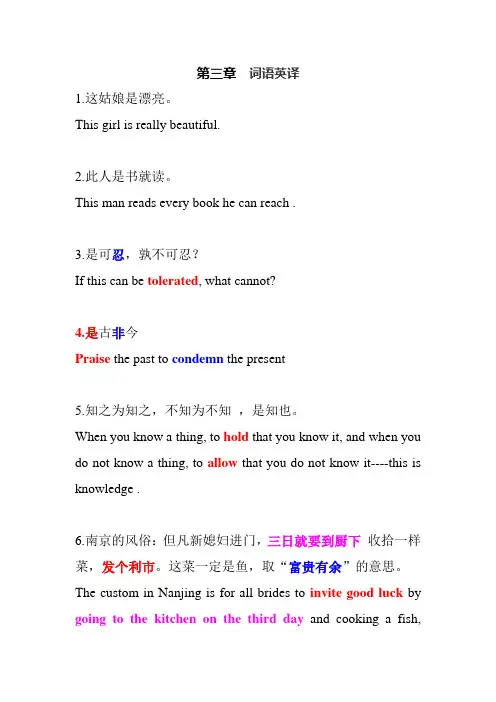
第三章词语英译1.这姑娘是漂亮。
This girl is really beautiful.2.此人是书就读。
This man reads every book he can reach .3.是可忍,孰不可忍?If this can be tolerated, what cannot?4.是古非今Praise the past to condemn the present5.知之为知之,不知为不知,是知也。
When you know a thing, to hold that you know it, and when you do not know a thing, to allow that you do not know it----this is knowledge .6.南京的风俗:但凡新媳妇进门,三日就要到厨下收拾一样菜,发个利市。
这菜一定是鱼,取“富贵有余”的意思。
The custom in Nanjing is for all brides to invite good luck by going to the kitchen on the third day and cooking a fish,which stands for fortune.7.去设埋伏我们都没有信心,想他一定在昨天晚上就早溜了,今天去也是瞎子点灯白费蜡。
We had no confidence in today's ambush because we were sure he had escaped last night. It seemed as useless as a blind man lighting a candle.8.……只因生得妩媚风流,满学中都送了两个外号:一个叫“香怜”,一个叫“玉爱”。
... Because of their glamorous looks and affected manners, were universally known by the nickname of Darling and Precious.9.克明:觉新哪,你听着!Keming: Juexin, I want you to pay particular attention to this.10.客人一走进大门,扑鼻的是一阵幽香,入目的是绿蜡似的叶子和红霞或白雪似的花朵……As guests entered the gate, they would first smell a sweet fragrance and then see the waxy green leaves and the rainbow red or snow-white flowers.11.……三十六家花酒店,七十二座管弦楼。

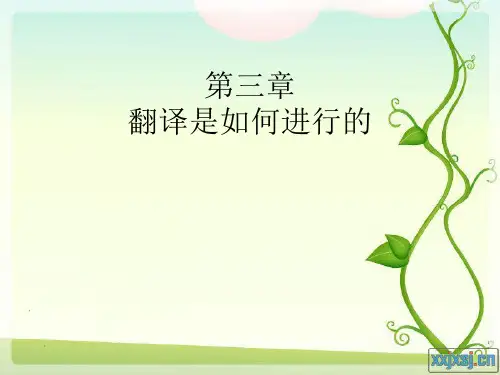
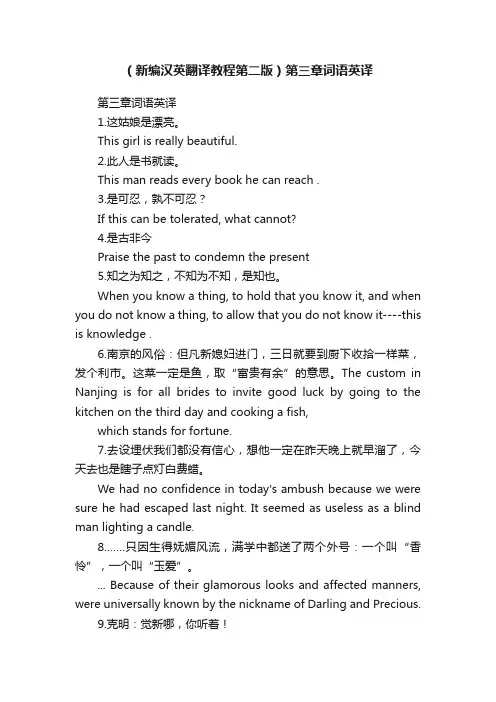
(新编汉英翻译教程第二版)第三章词语英译第三章词语英译1.这姑娘是漂亮。
This girl is really beautiful.2.此人是书就读。
This man reads every book he can reach .3.是可忍,孰不可忍?If this can be tolerated, what cannot?4.是古非今Praise the past to condemn the present5.知之为知之,不知为不知,是知也。
When you know a thing, to hold that you know it, and when you do not know a thing, to allow that you do not know it----this is knowledge .6.南京的风俗:但凡新媳妇进门,三日就要到厨下收拾一样菜,发个利市。
这菜一定是鱼,取“富贵有余”的意思。
The custom in Nanjing is for all brides to invite good luck by going to the kitchen on the third day and cooking a fish,which stands for fortune.7.去设埋伏我们都没有信心,想他一定在昨天晚上就早溜了,今天去也是瞎子点灯白费蜡。
We had no confidence in today's ambush because we were sure he had escaped last night. It seemed as useless as a blind man lighting a candle.8.……只因生得妩媚风流,满学中都送了两个外号:一个叫“香怜”,一个叫“玉爱”。
... Because of their glamorous looks and affected manners, were universally known by the nickname of Darling and Precious.9.克明:觉新哪,你听着!Keming: Juexin, I want you to pay particular attention to this.10.客人一走进大门,扑鼻的是一阵幽香,入目的是绿蜡似的叶子和红霞或白雪似的花朵……As guests entered the gate, they would first smell a sweet fragrance and then see the waxy green leaves and the rainbow red or snow-white flowers.11.……三十六家花酒店,七十二座管弦楼。
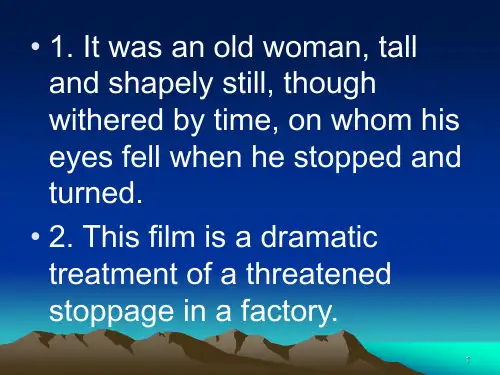
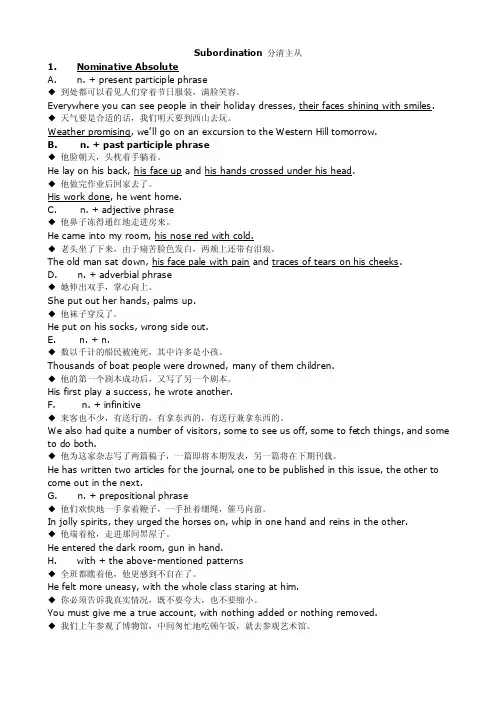
Subordination分清主从1. Nominative AbsoluteA. n. + present participle phrase◆到处都可以看见人们穿着节日服装,满脸笑容。
Everywhere you can see people in their holiday dresses, their faces shining with smiles.◆天气要是合适的话,我们明天要到西山去玩。
Weather promising, we’ll go on an excursion to the Western Hill tomorrow.B. n. + past participle phrase◆他脸朝天,头枕着手躺着。
He lay on his back, his face up and his hands crossed under his head.◆他做完作业后回家去了。
His work done, he went home.C. n. + adjective phrase◆他鼻子冻得通红地走进房来。
He came into my room, his nose red with cold.◆老头坐了下来,由于痛苦脸色发白,两颊上还带有泪痕。
The old man sat down, his face pale with pain and traces of tears on his cheeks.D. n. + adverbial phrase◆她伸出双手,掌心向上。
She put out her hands, palms up.◆他袜子穿反了。
He put on his socks, wrong side out.E. n. + n.◆数以千计的船民被淹死,其中许多是小孩。
Thousands of boat people were drowned, many of them children.◆他的第一个剧本成功后,又写了另一个剧本。
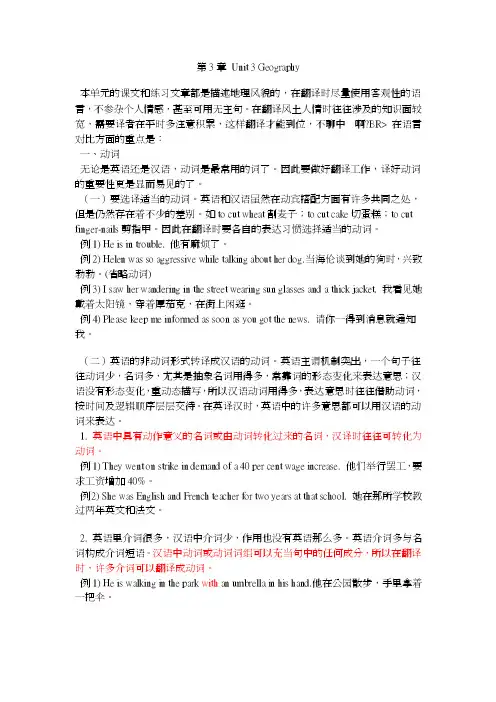
第3章Unit 3 Geography本单元的课文和练习文章都是描述地理风貌的,在翻译时尽量使用客观性的语言,不参杂个人情感,甚至可用无主句。
在翻译风土人情时往往涉及的知识面较宽,需要译者在帄时多注意积累,这样翻译才能到位,不聊中 啊?BR> 在语言对比方面的重点是:一、动词无论是英语还是汉语,动词是最常用的词了。
因此要做好翻译工作,译好动词的重要性更是显而易见的了。
(一)要选译适当的动词。
英语和汉语虽然在动宾搭配方面有许多共同之处,但是仍然存在着不少的差别。
如to cut wheat割麦子;to cut cake切蛋糕;to cut finger-nails剪指甲。
因此在翻译时要各自的表达习惯选择适当的动词。
例1) He is in trouble. 他有麻烦了。
例2) Helen was so aggressive while talking about her dog.当海伦谈到她的狗时,兴致勃勃。
(省略动词)例3) I saw her wandering in the street wearing sun glasses and a thick jacket. 我看见她戴着太阳镜,穿着厚茄克,在街上闲逛。
例4) Please keep me informed as soon as you got the news. 请你一得到消息就通知我。
(二)英语的非动词形式转译成汉语的动词。
英语主谓机制突出,一个句子往往动词少,名词多,尤其是抽象名词用得多,常靠词的形态变化来表达意思;汉语没有形态变化,重动态描写,所以汉语动词用得多,表达意思时往往借助动词,按时间及逻辑顺序层层交待。
在英译汉时,英语中的许多意思都可以用汉语的动词来表达。
1. 英语中具有动作意义的名词或由动词转化过来的名词,汉译时往往可转化为动词。
例1) They went on strike in demand of a 40 per cent wage increase. 他们举行罢工,要求工资增加40%。
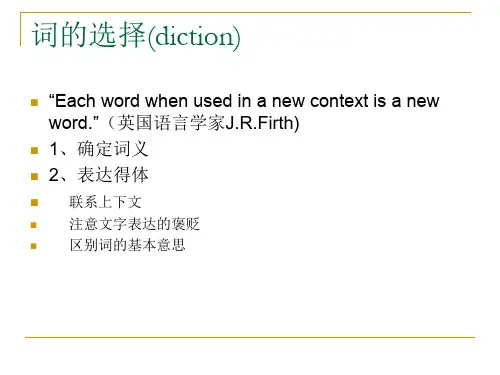
![[VIP专享]了不起的盖茨比第三章中英翻译The Great Gatsby Chapter 3](https://uimg.taocdn.com/43e3407c83c4bb4cf7ecd198.webp)
Chapter 3THERE was music from my neighbor's house through the summer nights. In his blue gardens men and girls came and went like moths among the whisperings and the champagne and the stars. At high tide in the afternoon I watched his guests diving from the tower of his raft, or taking the sun on the hot sand of his beach while his two motor−boats slit the waters of the Sound, drawing aquaplanes over cataracts of foam. On week−ends his Rolls−Royce became an omnibus, bearing parties to and from the city between nine in the morning and long past midnight, while his station wagon scampered like a brisk yellow bug to meet all trains. And on Mondays eight servants, including an extra gardener, toiled all day with mops and scrubbing−brushes and hammers and garden−shears,repairing the ravages of the night before.Every Friday five crates of oranges and lemons arrived from a fruitier in New York every Monday these same oranges and lemons left his back door in a pyramid of pulp less halves. There was a machine in the kitchen which could extract the juice of two hundred oranges in half an hour if a little button was pressed two hundred times by a butler's thumb.At least once a fortnight a corps of caterers came down with several hundred feet of canvas and enough colored lights to make a Christmas tree of Gatsby's enormous garden. On buffet tables, garnished with glistening hors−d'oeuvre,spiced baked hams crowded against salads of harlequin designs and pastry pigs and turkeys bewitched to a dark gold. In the main hall a bar with a real brass rail was set up, and stocked with gins and liquors and with cordials so long forgotten that most of his female guests were too young to know one from another.总是有悠扬的音乐在夏夜的晚上从我隔壁传出。
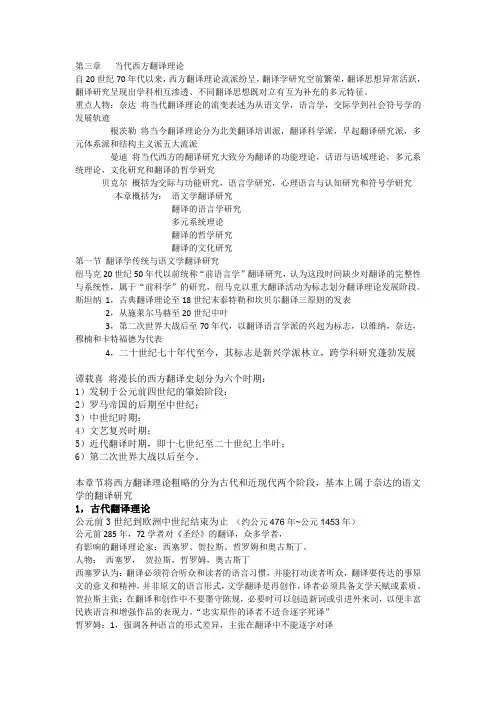
第三章当代西方翻译理论自20世纪70年代以来,西方翻译理论流派纷呈,翻译学研究空前繁荣,翻译思想异常活跃,翻译研究呈现出学科相互渗透、不同翻译思想既对立有互为补充的多元特征。
重点人物:奈达将当代翻译理论的流变表述为从语文学,语言学,交际学到社会符号学的发展轨迹根茨勒将当今翻译理论分为北美翻译培训派,翻译科学派,早起翻译研究派,多元体系派和结构主义派五大流派曼迪将当代西方的翻译研究大致分为翻译的功能理论,话语与语域理论,多元系统理论,文化研究和翻译的哲学研究贝克尔概括为交际与功能研究,语言学研究,心理语言与认知研究和符号学研究本章概括为:语文学翻译研究翻译的语言学研究多元系统理论翻译的哲学研究翻译的文化研究第一节翻译学传统与语文学翻译研究纽马克20世纪50年代以前统称“前语言学”翻译研究,认为这段时间缺少对翻译的完整性与系统性,属于“前科学”的研究,纽马克以重大翻译活动为标志划分翻译理论发展阶段。
斯坦纳1,古典翻译理论至18世纪末泰特勒和坎贝尔翻译三原则的发表2,从施莱尔马赫至20世纪中叶3,第二次世界大战后至70年代,以翻译语言学派的兴起为标志,以维纳,奈达,穆楠和卡特福德为代表4,二十世纪七十年代至今,其标志是新兴学派林立,跨学科研究蓬勃发展谭载喜将漫长的西方翻译史划分为六个时期:1)发轫于公元前四世纪的肇始阶段;2)罗马帝国的后期至中世纪;3)中世纪时期;4)文艺复兴时期;5)近代翻译时期,即十七世纪至二十世纪上半叶;6)第二次世界大战以后至今。
本章节将西方翻译理论粗略的分为古代和近现代两个阶段,基本上属于奈达的语文学的翻译研究1,古代翻译理论公元前3世纪到欧洲中世纪结束为止(约公元476年~公元1453年)公元前285年,72学者对《圣经》的翻译,众多学者,有影响的翻译理论家:西塞罗、贺拉斯、哲罗姆和奥古斯丁。
人物:西塞罗,贺拉斯,哲罗姆,奥古斯丁西塞罗认为:翻译必须符合听众和读者的语言习惯,并能打动读者听众,翻译要传达的事原文的意义和精神,并非原文的语言形式,文学翻译是再创作,译者必须具备文学天赋或素质。
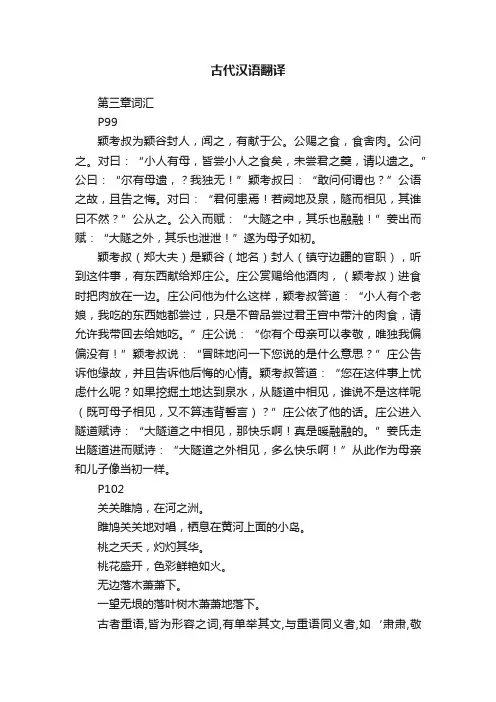
古代汉语翻译第三章词汇P99颖考叔为颖谷封人,闻之,有献于公。
公赐之食,食舍肉。
公问之。
对曰:“小人有母,皆尝小人之食矣,未尝君之羹,请以遗之。
”公曰:“尔有母遗,?我独无!”颖考叔曰:“敢问何谓也?”公语之故,且告之悔。
对曰:“君何患焉!若阙地及泉,隧而相见,其谁曰不然?”公从之。
公入而赋:“大隧之中,其乐也融融!”姜出而赋:“大隧之外,其乐也泄泄!”遂为母子如初。
颖考叔(郑大夫)是颖谷(地名)封人(镇守边疆的官职),听到这件事,有东西献给郑庄公。
庄公赏赐给他酒肉,(颖考叔)进食时把肉放在一边。
庄公问他为什么这样,颖考叔答道:“小人有个老娘,我吃的东西她都尝过,只是不曾品尝过君王宫中带汁的肉食,请允许我带回去给她吃。
”庄公说:“你有个母亲可以孝敬,唯独我偏偏没有!”颖考叔说:“冒昧地问一下您说的是什么意思?”庄公告诉他缘故,并且告诉他后悔的心情。
颖考叔答道:“您在这件事上忧虑什么呢?如果挖掘土地达到泉水,从隧道中相见,谁说不是这样呢(既可母子相见,又不算违背誓言)?”庄公依了他的话。
庄公进入隧道赋诗:“大隧道之中相见,那快乐啊!真是暖融融的。
”姜氏走出隧道进而赋诗:“大隧道之外相见,多么快乐啊!”从此作为母亲和儿子像当初一样。
P102关关雎鸠,在河之洲。
雎鸠关关地对唱,栖息在黄河上面的小岛。
桃之夭夭,灼灼其华。
桃花盛开,色彩鲜艳如火。
无边落木萧萧下。
一望无垠的落叶树木萧萧地落下。
古者重语,皆为形容之词,有单举其文,与重语同义者,如‘肃肃,敬也’,‘丕丕,大也’,只言“肃”、只言‘丕’,亦为“敬也”、“大也”;有单举其文即与重语异义者,如‘坎坎,喜也’,‘居居,恶也’,只言‘坎’,只言‘居’,则非“喜”与“恶”矣。
燕燕于飞,差池其羽。
燕子天上飞翔,参差舒展翅膀。
行行重行行,与君生别离。
走了又走,不停地走,和你活生生地离别。
树树皆秋色,山山惟落晖。
每一棵树都染上秋天的色彩,每一座山都披上落日的余晖。
Chapter 3THERE was music from my neighbor's house through the summer nights. In his blue gardens men and girls came and went like moths among the whisperings and the champagne and the stars. At high tide in the afternoon I watched his guests diving from the tower of his raft, or taking the sun on the hot sand of his beach while his two motor−boats slit the waters of the Sound, drawing aquaplanes over cataracts of foam. On week−ends his Rolls−Royce became an omnibus, bearing parties to and from the city between nine in the morning and long past midnight, while his station wagon scampered like a brisk yellow bug to meet all trains. And on Mondays eight servants, including an extra gardener, toiled all day with mops and scrubbing−brushes and hammers and garden−shears, repairing the ravages of the night before.Every Friday five crates of oranges and lemons arrived from a fruitier in New York every Monday these same oranges and lemons left his back door in a pyramid of pulp less halves. There was a machine in the kitchen which could extract the juice of two hundred oranges in half an hour if a little button was pressed two hundred times by a butler's thumb.At least once a fortnight a corps of caterers came down with several hundred feet of canvas and enough colored lights to make a Christmas tree of Gatsby's enormous garden. On buffet tables, garnished with glistening hors−d'oeuvre, spiced baked hams crowded against salads of harlequin designs and pastry pigs and turkeys bewitched to a dark gold. In the main hall a bar with a real brass rail was set up, and stocked with gins and liquors and with cordials so long forgotten that most of his female guests were too young to know one from another.总是有悠扬的音乐在夏夜的晚上从我隔壁传出。
论语第三章原文和翻译《论语》是儒家学派的经典著作之一,以下是小编给大家整理收集的论语第三章原文和翻译,供大家阅读参考。
1、孔子谓季氏:“八佾舞于庭,是可忍也,孰不可忍也?”译文:孔子谈到季氏时说:“用天子的礼乐(八佾舞)在他家的庭院中祭祀祖先(越礼),对于季氏这样的事情都可以容忍,还哪些事情不可以容忍呢?”2、三家者以雍彻。
子曰:“‘相维辟公,天子穆穆’,奚取于三家之堂?”译文:孟孙、叔孙、季孙三家卿大夫,祭祀祖先时,按照天子的礼制唱着《雍》来撤除祭品。
孔子说:“《诗经》上说,‘天子祭祀宗庙,天下各路诸侯都来助祭,天子庄重肃穆地主祭。
’这两句话用在三家祭祀的庙堂之上,天下哪一个诸侯会来陪祭呢?”3、子曰:“人而不仁,如礼何?人而不仁,如乐何?”译文:孔子说:“一个人没有真诚的心意,能用礼做什么呢?一个人没有真诚的心意,能用乐做什么呢?”4、林放问礼之本。
子曰:“大哉问!礼,与其奢也,宁俭;丧,与其易也,宁戚。
”译文:林放向孔子请教礼的根本道理。
孔子说:“你提的真是大问题啊!一般的礼与其辅张奢侈,宁可简约朴素;至于丧礼,与其仪式周全,不如心中哀戚。
”5、子曰:“夷狄之有君,不如诸夏之亡也。
”译文:孔子说:“夷狄(中原之外的少数民族)都有自己的君主,不像诸夏(中原各国)这些国家没有君主(因为时代很乱,弑父弑君的事情时常发生)。
”不如:不像。
6、季氏旅于泰山。
子谓冉有曰:“女弗能救与?”对曰:“不能。
”子曰:“呜呼!曾谓泰山不如林放乎?”译文:季氏要去祭祀泰山(违背了礼)。
孔子对冉有说:“你不能劝阻他吗?”冉有说:“不能(当时冉有为季氏家臣)。
”孔子说:“唉!难道说泰山之神还不如林放懂礼吗?(或:难道说泰山之神能够接受季氏这种不合礼的祭祀吗?)”7、子曰:“君子无所争。
必也射乎!揖让而升,下而饮。
其争也君子。
”译文:孔子说:“君子没有什么可争的。
如果一定要有,那就比赛射箭吧!比赛时上下台阶与饮酒,都拱手作礼,互相谦让,这样的竞争,也是很有君子风度的。
Little Prince[ Chapter 3 ]- the narrator learns more about from where the little prince cameIt took me a long time to learn where he came from. The little prince, who asked me so many questions, never seemed to hear the ones I asked him. It was from words dropped by chance that, little by little, everything was revealed to me.The first time he saw my airplane, for instance (I shall not draw my airplane;that would be much too complicated for me), he asked me: "What is that object?""That is not an object. It flies. It is an airplane. It is my airplane." And I wasproud to have him learn that I could fly.He cried out, then: "What! You dropped down from the sky?""Yes," I answered, modestly."Oh! That is funny!"And the little prince broke into a lovely peal of laughter, which irritated mevery much. I like my misfortunes to be taken seriously.Then he added: "So you, too, come from the sky! Which is your planet?"At that moment I caught a gleam of light in the impenetrable mystery of his presence; and I demanded, abruptly: "Do you come from another planet?"But he did not reply. He tossed his head gently, without taking his eyes frommy plane: "It is true that on that y ou can‘t have come from very far away..."小王子【第三章】-叙述者知道了更多关于小王子是从哪里来的的事搞清楚他从哪里来用了我很长时间。
第三周,英汉语言对比与翻译一,翻译中英汉语言对比的重要意义Jean Delisle, representative of French Interpretative Theory of Translation, says in his Translation: An Interpretive Approach, “In other words, each community has developed habits of expression that, over time, have been integrated into the language and lent it certain characteristics.”1He also quotes from Edmond Cary: “Two languages can both be inflected and belong to the same family yet nevertheless differ considerably in the way they express ideas and convey meanings.”1. Delisle, J. Translation: An Interpretive Approach[M]. Eng. trans, by Logan. P & Creery. M., Ottawa: University of Ottawa Press, 1980: 74傅雷在《〈高老头〉重译本序》中说:“译本与原作,文字既不侔,规则又大异。
各种文字各有特色,各有无可模仿的优点,各有无法补救的缺陷,同时又各有不能侵犯的戒律。
像英、法,英、德那样接近的语言,尚且有许多难以互译的地方;中西文字的格远过于此,要求传神达意,铢两悉称,自非死抓字典,按照原文句法拼凑堆砌所能济事。
”11. 怒安. 傅雷谈翻译[M]. 沈阳:辽宁教育出版社2005:1他也谈到了改变句法结构和保留句法结构之间的辩证关系:“我不是说原文的句法绝对可以不管,在最大限度内我们是要保持原文句法的,但无论如何,要叫人觉得尽管句法新奇而仍不失为中文。
这一点当然是不容易做到的,……”11. 怒安. 傅雷谈翻译[M]. 沈阳:辽宁教育出版社2005:30就保留原文句法与译文体现原作精神的问题,傅雷也有精辟的论述:“假如破坏本国文字的结构与特性,就能传达异国文字的特性而获得原作的精神,那么翻译真是太容易了。
不幸那种理论非但是刻船求剑,而且结果是削足就履,两败俱伤。
”11. 怒安. 傅雷谈翻译[M]. 沈阳:辽宁教育出版社2005:2刘宓庆:“西方各语种在SLT与TLT之间的实现形式转换的可行性比汉外翻译大得多。
……即既实现意义对应,又实现形式对应。
这在汉语与西方语言之间的转换中是根本办不到的。
基本上,汉外互译必须放弃拘守形式的努力而倾全力于意义。
”1思果说:“千万不能跟英文走。
” 2 1.刘宓庆.翻译与语言哲学[M].北京:中国对外翻译出版公司,2001: 78.)2.思果. 翻译研究[M]. 北京:中国对外翻译出版公司, 2001:23)二,汉语的线性序列与英语的空间结构1,关于英汉语言的比喻英语句子的结构: “葡萄藤型”结构(grapevine structure),意为在短短的主干上派生出长长的枝蔓和丰硕的果实;英语句子的结构: 汉语句子因为很少叠床架屋,节外生枝,而是一个短句接一个短句地往下延伸,因此被称为“竹竿型”结构(bamboo structure)。
1 1. 王寅. 英汉语言宏观结构区别特征. 载方梦之、马秉义编选《汉译英实践与技巧》[M]. 北京:旅游教育出版社,1996: 42“波浪形”结构:汉语的句子关系往往是并列、并行的,因此是以时序或逻辑顺序排列的。
子句与子句之间的关系须透过上下文才能决定,所以句子是意合的;而且连词的使用也不像英语中普遍,结构也较为简练明快。
汉语的句式称之为“流水句”,整个句子像由一个一个独立的子句,按时间顺序或逻辑顺序层层推进。
因此,有人把汉语句子结构比作“波浪形”结构,每个子句犹如波浪,前浪推后浪,宛如“万顷碧波,层层推进”。
“枝杈形结构”:英语采用主从关系的形合法(use of hypotaxis)。
英语可以通过连词(如状语从句)、关系词(如定语从句)和分词、动名词及不定式等构成句子,因此构成方式是形合的;英语利用关系代词引出包孕句(embedded clause),语法结构采用层次结构,关系紧凑严密。
也就是说,英语的句子结构是在一个主句中,可在不同的地方插入各种从属结构,层层展开。
从属结构包括动词的非限定形式、介词短语和各种从句。
有人把英语句子结构比作树状的“枝杈形”结构,犹如“参天大树,枝叶横生”。
1 1. 郭建中. 汉英/英汉翻译:理念与方法[J]. 上海翻译, 2006(01):18-19英语造句着重用关联词语将句子的主干与上下左右勾连,进行空间搭架,因此可以称为“营造学手法”(architectural style),而汉语造句偏重从动词着眼,将各部分根据时间顺序一一予以安排,因此,可以称为“编年史手法”(chronicle style) 1 1.林同济. 从汉语词序看长句的翻译. 载方梦之、马秉义编选《汉译英实践与技巧》[M]. 北京:旅游教育出版社,1996: 433-4陈安定:英语句子好比“一串珍珠”,而汉语句子则像“一盘大小各异的珍珠,散落玉盘,闪闪发光,灿烂夺目。
”1比喻归纳:“英语句子好比一棵参天大树,一串葡萄,一串珍珠,一树荔枝。
而汉语(句子)好比一根竹子,一盘珠子,一江波涛。
” 2 1,2. 陈安定. 英汉比较与翻译[M]. 北京:中国对外翻译出版公司1998: 7; 5以上比喻可以说基本上代表了英汉对比研究领域对这英汉两种语言各自总体特征的认识。
这里我们把它们统一为汉语的线性序列结构和英语的空间结构。
天目山林深人少,古树掩映,清泉石上流,雾生半山腰,如仙境一般。
Mt. Tianmu, densely forested and scarcely populated, is like a fairyland where heavy fogs envelop halfway up the mountain and clear streams flow along the valleys.densely forested and scarcely populated,Mt. Tianmu, is like a fairylandwhere heavy fogs envelop halfway up the mountain and clear streams flow along the valleys.理论认识层面:翻译就是重构(Translating is restructuring.)。
Nida: “To preserve the content of the message the form must be changed.”1Nida: “If all languages differ in form (and this is the essence of their being different languages), then quite naturally the forms must be altered if one is to preserve the content.”1 1. Nida, E.A. &Taber. C. R. The Theory and Practice of Translation[M]. Leiden: Brill, 1982:5. Delisle:Translation is an art of re-expression based on writing techniques and a knowledge of two languages. 1“…and re-expression (to reconstruct the text in another language [writing techniques].”2 1、2. Delisle, J. Translation: An Interpretive Approach[M]. Eng. trans, by Logan. P & Creery. M., Ottawa: University of Ottawa Press, 1980: 3;83“It is the meaning of a message that is transferred from one language to another, and the transfer is accomplished by analyzing and then reconstructing semantic relationships.”1“Translation can therefore be defined as the operation by which the relevant signification of linguistic signs is determined through reference to a meaning as formulated in a message, which is then fully reconstructed in the signs of another language.” 2 1、2. Delisle, J. Translation: An Interpretive Approach[M]. Eng. trans, by Logan. P & Creery. M., Ottawa: University of Ottawa Press, 1980: 3;52实践指导意义:翻译成功的关键之一,就是要实现句子结构之间的转换。
汉译英时,要把汉语的线性序列,转换成英语的空间结构,这能在很大程度上避免所谓的Chinglish。
英译汉时,要把英语的空间结构,转换成汉语的线性序列,这能在很大程度上避免所谓的“欧化”句子。
四,对英汉比喻的错误定位把汉语的线性序列和英语的空间结构与英汉语形合与意合对应起来,把上述提及到的比喻都认为是形合和意合的形象表达。
而形合与意合的内涵实际上是关于句子衔接的问题,主张在汉译英时添加应有的连接词,或者在英译汉时省略连接词。
连接词的使用与否不能保证译成的汉语就是线性序列的,或者译成的英语就是空间结构的。